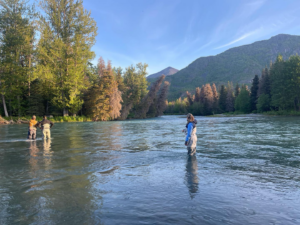The annual silver salmon run on the Kenai River is a breathtaking spectacle that showcases the resilience and determination of these remarkable fish.
As they journey from the vastness of the ocean to the freshwater rivers of their birth, salmon navigate a complex network of environmental cues and internal compasses.
If you’re about to try your hand at salmon fishing on the Kenai River, make sure you understand the science behind salmon migration patterns. Keep reading.
The Instinctive Drive to Spawn
Silver Salmon are anadromous fish, meaning they are born in freshwater, migrate to the ocean to mature, and then return to their natal rivers to spawn and complete their life cycle. This epic journey, spanning thousands of miles, is driven by a powerful instinctual urge to reproduce.
As silver salmon approach their spawning grounds, they undergo a series of physiological and behavioral changes. Their bodies transform, their colors shift, and their focus narrows to the single-minded pursuit of reproduction. This transformation, driven by hormonal changes and environmental cues, fuels their relentless journey upstream.
A Feat of Orientation

Silver salmon spend several years maturing in the vast expanse of the ocean, typically for about one to three years. During this period, they encounter a multitude of challenges and navigate thousands of miles. Their ability to find their way back to the exact river where they were born, often after years of absence, has long captivated scientists and nature enthusiasts alike.
This remarkable feat of orientation is achieved through a combination of sophisticated navigational tools, including geomagnetic cues, celestial navigation, and olfactory imprinting.
Geomagnetic cues, derived from the Earth’s magnetic field, act as a compass for salmon, providing them with a sense of direction and allowing them to maintain a general course towards their destination. This internal compass helps them navigate the open ocean, even in the absence of familiar landmarks or visual cues.
However, the most intriguing aspect of silver salmon navigation is their olfactory imprinting. During their early life stages, salmon imprint on the unique chemical signature of their natal stream. This scent, a complex blend of organic compounds and minerals specific to their birthplace, becomes etched in their memory. As they approach the coastline, their sense of smell becomes increasingly acute, allowing them to detect the faintest traces of their home river’s unique aroma from miles away.
This olfactory homing mechanism guides them through a maze of waterways, leading them unerringly back to the very spot where their life began.
The Role of Environmental Cues

The timing and success of silver salmon migration are heavily influenced by a complex interplay of environmental cues. These natural signals, including water temperature, flow rate, and day length, act as triggers and guides, providing salmon with crucial information about the optimal time to begin their journey and the conditions they are likely to encounter along the way.
Water temperature plays a particularly important role in salmon migration. As temperatures rise in the spring, it signals to salmon in the ocean that it’s time to begin their journey back to freshwater. The warmer waters stimulate physiological changes in the fish, preparing them for the transition from saltwater to freshwater and the rigors of upstream migration.
Similarly, changes in day length, or photoperiod, act as a powerful internal clock for salmon. As the days lengthen in the spring and summer, it triggers hormonal changes that promote reproductive readiness and the urge to migrate. The shortening days of autumn, on the other hand, signal to salmon that it’s time to spawn and complete their life cycle.
Flow rate, or the speed and volume of water moving in the river, also influences salmon migration. High flows can make upstream travel more challenging, while low flows can impede access to spawning grounds. Salmon are adept at navigating various flow regimes, but understanding these patterns can help anglers predict where fish are most likely to congregate.
By understanding these environmental triggers and their impact on salmon behavior, anglers can gain a significant advantage on the water. By aligning their fishing trips with optimal conditions and targeting areas where salmon are likely to be present, they can increase their chances of success and experience the thrill of catching these remarkable fish.
The Kenai River: A Salmon Superhighway
The Kenai River, with its pristine waters and abundant food sources, is a vital corridor for several species of salmon, including sockeye and silver salmon. These fish, drawn by the river’s favorable conditions, make their way upstream in massive numbers each summer and fall. The Kenai’s diverse habitats, ranging from fast-flowing rapids to tranquil pools, provide ideal spawning and rearing grounds for salmon.
Recommended Read: 8 Essential Questions to Ask Your Kenai River Fishing Guide
The Angler’s Advantage: Understanding Migration Patterns

For anglers seeking to experience the thrill of silver salmon fishing on the Kenai River, understanding the science behind salmon migration patterns is essential. By understanding when and where salmon are likely to be found, anglers can increase their chances of success and make the most of their time on the water.
Experienced Kenai River salmon fishing guides possess a deep understanding of these migration patterns, honed through years of observation and experience. They know the prime fishing spots, the most effective techniques, and the subtle cues that indicate when the fish are biting.
At Jason’s Guide Service, we take pride in sharing our expertise and experience with you. Our goal is to ensure you have a successful, enjoyable, and memorable guided fishing trip. If you think it’s time to explore silver salmon fishing in Cooper Landing, our dedicated guides are here to help.

















